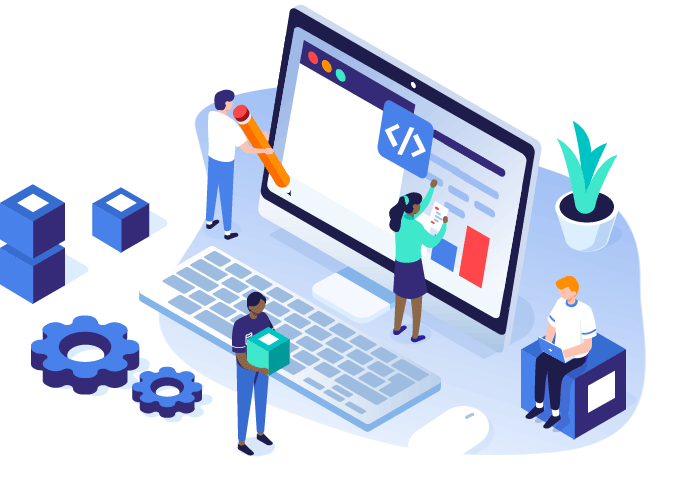Experience Meets Innovation:
Revolutionizing Front-End Development
Where impeccable design meets seamless functionality. Experience the future of front-end development with us

Front-end Development
In today's digital age, the face of your online presence is often the first touchpoint for potential clients, users, and partners. Front-end development, responsible for crafting that face, is not merely about making a website look good. It's about creating a seamless, intuitive, and engaging experience that leaves an indelible impression, enabling businesses to effectively communicate their brand and mission while ensuring users are satisfied, engaged, and eager to return. This delicate balance of aesthetics and functionality, achievable through expert front-end development, is paramount for any business aiming to thrive online.
As digital landscapes become more complex and user expectations continue to rise, the role of front-end development becomes even more crucial. Websites are no longer static billboards; they are interactive platforms that need to adapt to user behaviour, device, and even changing global standards. With our specialized front-end development services, we provide the expertise to ensure your online presence stands out, adapts, and delivers a premium user experience, propelling your brand to the forefront of the digital realm.


Responsive Web Design
Crafting websites that look and function flawlessly across all devices – be it a desktop, tablet, or mobile.

Performance Optimization
Ensuring fast load times and smooth interactions, crucial for retaining users and improving search rankings.

Interactive Web Elements
Integrating animations, transitions, and interactive features that engage users and drive conversions.

Web Accessibility
Making websites usable for everyone, including users with disabilities, ensuring you cater to a wider audience and comply with global standards.

Cross-Browser Compatibility
Ensuring your website looks and works perfectly across all modern browsers, offering a consistent experience for all users.

Custom Theme Development
Crafting unique themes tailored to your brand, ensuring a distinct online identity that separates you from competitors.

Single Page Applications
Designing applications that load a single HTML page and dynamically update as the user interacts, offering a seamless user experience.

Progressive Web Apps
Building web applications that offer a mobile-app-like experience on websites, ensuring offline functionality, push notifications, and fast load times.

API Integrations
Seamlessly integrating third-party applications and services into your website, enhancing its functionality and ensuring smooth user interactions.
Front-End Development and Web Development are terms that are often used interchangeably, but they refer to distinct areas of expertise in the process of creating websites and web applications. This section aims to shed light on the key differences between Front-End Development and Web Development, helping readers gain a clear understanding of each role and their respective responsibilities in the web development process.
| Front-End Development | Website Development |
|---|---|
Definition:Front-end development refers to the construction of the user-facing aspects of a website, focusing on design, layout, and interactivity using HTML, CSS, and JavaScript for enhanced user experience. | Definition:Website development is the process of designing, coding, and maintaining websites to create online platforms for various purposes. It involves both visual and technical aspects to ensure functionality, usability, and user experience. |
Components:
| Components:
|
Technologies Used:
| Technologies Used:
|
Role & Responsibility:Ensuring the website looks good across all devices (responsive design). Creating a visually appealing and intuitive interface. Implementing user feedback loops for continuous UI/UX improvement. | Role & Responsibility:Front-End Developers work on the visual and interactivity aspects. Back-End Developers manage server-side operations, databases, and API integrations. Full Stack Developers handle both front-end and back-end. Webmasters or IT teams often handle deployment and hosting. |
Front-end development involves using HTML, Styles and designs of the content, including colors, fonts, and layouts, and JavaScript to create user interfaces and enhance user experience on websites and applications.
As more users access websites via mobile devices, having a site that adapts to different screen sizes ensures a consistent user experience, reducing bounce rates and increasing engagement.
A fast-loading site not only provides a better user experience but also ranks higher in search engine results, drawing more organic traffic.
Web accessibility ensures your site can be used by individuals with disabilities, expanding your audience reach. It also has potential SEO benefits and ensures compliance with global regulations.
Yes, as technology and user expectations evolve, regular updates and checks are necessary to ensure your site remains current, secure, and optimized.
We test your website across a range of modern browsers, making necessary adjustments to ensure consistent display and functionality. Using advanced tools and best practices, we ensure every user has a premium browsing experience.
Embrace innovation with our IT development expertise - Contact us now to unlock your business growth!

